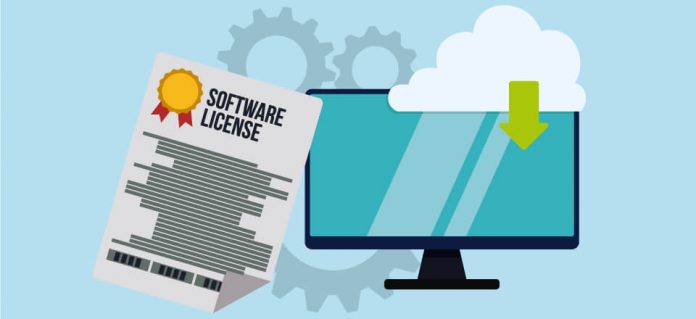This article has been written by Adv. Manjula K S pursuing a Diploma in Intellectual Property: Prosecution, licensing and litigation course from LawSikho.
This article has been edited and published by Shashwat Kaushik.
Table of Contents
Introduction
When a consumer buys a commodity from a manufacturer, there is a transfer of ownership. Now, the consumer owns that commodity and the manufacturer can no longer exercise his rights over it.
However, when it comes to selling software products by companies or manufacturers, a prominent question is whether the software is sold or licensed.’ The answer is that it is often done through the granting of a license rather than a sale. Since a license provides permission to use a product rather than ownership of the product, it allows software publishers to impose restrictions on how purchasers use their software.
When a customer or business purchases a piece of software, they’re not actually gaining ownership of the software at all. Instead, they are paying for the right to use the software. Ownership of these software applications remains with the software vendor.
What is an end-user license agreement
An End User License Agreement, abbreviated as EULA, is essentially an enterprise license agreement. It is a legal contract between the software company and the user or the purchaser of the software. It acts as an agreement of terms and conditions by granting the users the right to use the software application purchased from the company. End-User License Agreements (EULAs) are the legal contracts between the software developer or vendor and the user, outlining the terms and conditions under which the software can be used. These agreements often impose various legal restrictions and obligations on the user to protect the intellectual property rights of the developer. In simple terms, EULA’s provide a simple and efficient means of protecting a software publisher’s intellectual property.
Need for EULA’s in today’s time
An EULA is not mandated by the law, but it acts as a framework against legal hurdles that might arise in the future between the parties of the contract.
Unlike many physical products, where ownership changes hands once the transaction is finalised, purchasing software constitutes an ongoing relationship between the vendor and the user. This relationship requires setting boundaries. EULAs establish what the user can and cannot do with the software, set the terms of the agreement, clarify liability, and provide infringement information, specify disclaimers, and address how and when the right to use the application may be terminated.
A common misconception is that this legal contract only safeguards the interests of the vendor of the software. Taking cognizance of the fact that most EULA contracts are designed in a way that particularly safeguards the interests of the software manufacturers, they also do provide several advantages and benefits to the end users too.
Components in an EULA
The terms-and-conditions contract serves as a legally binding agreement between the software developer or provider and the end user. It comprises various clauses and provisions that outline the rights, responsibilities, and limitations associated with the use of the software. Some of the most common components found in such contracts include:
- Type and grant of license: This section specifies the type of license granted to the end-user. Common license types include perpetual licenses (unlimited use) and subscription-based licenses (limited-time use). It also outlines the conditions under which the software can be used, such as for personal or commercial purposes.
- Terms, terminologies, and definitions: This section provides clear definitions of key terms and phrases used throughout the contract. This helps ensure that both parties have a shared understanding of the language used.
- Copyright infringement clause: This clause protects the intellectual property rights of the software developer. It prohibits unauthorised copying, distribution, or modification of the software without the express permission of the copyright holder.
- Usage restrictions: This section outlines the limitations and restrictions on how the software can be used. It may include prohibitions against reverse engineering, decompiling, or creating derivative works based on the software.
- Warranty disclaimer: This clause disclaims any express or implied warranties regarding the performance, functionality, or compatibility of the software. It clarifies that the software is provided “as-is” and that the user assumes the risk associated with its use.
- Software updates: This section addresses the provision of software updates, patches, or new versions. It may specify the frequency of updates, the process for obtaining them, and any additional fees or charges associated with updates.
- Dispute resolutions: This clause outlines the steps to be taken in the event of a dispute or disagreement between the parties. It may include mediation, arbitration, or litigation as potential dispute resolution mechanisms.

These clauses and provisions work together to create a legally binding agreement that governs the relationship between the software developer and the end-user. They protect the rights of both parties and provide a framework for resolving any issues that may arise during the use of the software.
Legal framework involved in EULA contracts
Most of the EULA contracts, as discussed earlier, are via the provision of licenses. These licenses may prohibit the user from using the software on his device in a way that is not mentioned in the clauses. Although these agreements may contain negative terms or clauses, the restrictions imposed by EULA’s, however, are not insignificant or deterrent in nature. These restrictions are framed in a way to cater to the intellectual property rights of the developers and manufacturers of the software.
The legality of EULA is often recognised by most internet users. The legal framework involved in such contracts is broad and encompassing.
- EULA’s are nothing but contracts enforceable by law, according to Section 2(h) of the Indian Contract Act of 1872. Therefore, its legality depends on a valid offer, acceptance, consideration, etc.
- However, the current use of contract law to evaluate software license agreements is problematic, not because the doctrine is inadequate but because those who use the rhetoric of contracts have tended to impose an artificially static view of what contract law demands.
- Antitrust laws and intellectual property rights never go hand in hand. While the former focusses on sustained and fair competition, preventing anti-competitive practices, the latter provides the creator of any work with an exclusive right over that work and bars any other person or entity from using that creator’s work. EULA is governed by Intellectual Property Rights law, which provides the licensor with certain exclusive rights, giving them privilege as to determine how and when the licensee can use the software.
The Hon’ble Supreme Court, in a recent judgement, has recognised the validity of End User License Agreements (EULAs) through its verdict in the case of Engineering Analysis Centre of Excellence Pvt Ltd vs. The Commissioner of Income Tax. This landmark judgement revolves around the payment of consideration by Indian companies or end-users to utilise computer software obtained from foreign sources and whether such payments constitute taxable royalty.
In this case, the assessee, Engineering Analysis Centre of Excellence Pvt Ltd, had entered into EULAs with foreign software companies for the use of their software. The EULAs specified that the consideration paid by the assessee was for the right to use the software and did not include any payment for the underlying intellectual property.
The Commissioner of Income Tax, however, contended that the payments made by the assessee were in the nature of royalty and, therefore, subject to tax under the Income Tax Act, 1961. The Commissioner argued that the EULAs granted the assessee exclusive rights to use the software, which amounted to the transfer of intellectual property rights and, as such, attracted royalty tax.
The Supreme Court, however, disagreed with the Commissioner’s interpretation. The Court held that the payments made by the assessee were not in the nature of royalty but were merely for the right to use the software. The Court observed that the EULAs did not transfer any intellectual property rights to the assessee and that the assessee could not sub-license or distribute the software to third parties.
The Supreme Court’s judgement in this case is significant as it provides clarity on the taxability of payments made under EULAs. The Court’s decision confirms that payments made for the right to use software, without the transfer of intellectual property rights, do not constitute taxable royalty. This judgement provides much-needed guidance to Indian companies and end-users entering into EULAs with foreign software companies, ensuring certainty and predictability in their tax obligations.
Shrinkwrap and clickwrap licenses
- Shrink Wrap: Shrink Wrap Contracts or licenses are contracts where the acceptance is deemed to be given with the usage of the product or software. In simple terms, when a user or a consumer of a product or a software purchased online opens the wrapped bundle of the product, utilises the product, or does any other similar act, he is said to have accepted the terms and conditions of the contract.
- Click Wrap: Click Wrap Contracts are contracts between the product or software manufacturer and the user or the consumer, where the user agrees to the terms and conditions of the vendor or the provider before using the product or the software.
- Courts have distinguished between different types of agreements. Shrinkwrap agreements, which are enclosed with a product and deemed accepted when the package is opened, have been upheld in cases like ProCD, Inc. vs. Zeidenberg. Clickwrap agreements, where users click a button to indicate acceptance, are also generally enforceable if users had to take an affirmative action to agree, as seen in Feldman vs. Google, Inc.

Before the advent of such a spike in technological inventions, EULA’s were printed on the back of a software application, package, or product. According to the shrink wrap contract, the user is deemed to have consented to the terms, conditions, and restrictions imposed by the vendor on him during the period of contract between them.
Both the mentioned contracts, shrink wrap and click wrap licences, require the user or the purchaser to waive off certain rights of his under the Copyright Act and to adhere to the terms and conditions on the package of the software. This, along with the inability of the users to read the terms of the agreement before consenting to it, has made many legal scholars question the validity of such licences, which undermines the legal enforceability of these contracts.
Although there remain several shortcomings of these licenses in several jurisdictions, they are legally binding in a majority of them.
Contrastingly, a free software license grants the users and purchasers of any software the rights to use, modify, distribute, and redistribute it without any restrictions imposed on them. This goes in hand with the anti-trust laws around the world but severely undermines the intellectual property rights of the manufacturer of the software. These kinds of licenses are, however, accompanied by a disclaimer of warranty.
In the landmark case of Shree Vardhman Rice & Gen Mills vs. Amarsingh Chawalwala, the Hon’ble Apex Court of India delivered a significant judgement that underscored the fundamental principle of contract law: parties must adhere to the terms of their agreements unless they are found to be illegal or against public policy. This ruling has far-reaching implications, particularly in the context of End-User License Agreements (EULAs).
EULAs are legal agreements between software developers and users that govern the use of software applications. They typically outline the terms and conditions of use, including restrictions, warranties, and limitations of liability. The Apex Court’s emphasis on the enforceability of EULAs, provided their terms are lawful and agreed upon by both parties, reinforces the sanctity of contractual obligations in the digital age.
The judgement in Shree Vardhman Rice & Gen Mills vs. Amarsingh Chawalwala serves as a reminder that parties cannot simply disregard the terms of their agreements once they have been entered into. If a party enters into an EULA and subsequently breaches its terms, they may be held legally liable for any resulting damages or losses. This principle helps to maintain fairness and predictability in commercial transactions.
Furthermore, the court’s recognition of the enforceability of EULAs highlights the importance of informed consent in the digital age. Software developers must ensure that users have a clear understanding of the terms and conditions of the EULA before they agree to them. This can be achieved through transparent and easily accessible language, as well as opportunities for users to seek clarification or advice if necessary.
The judgement also serves as a caution to software developers against including unfair or overly restrictive terms in their EULAs. Courts are increasingly scrutinising EULAs for provisions that may be considered unconscionable or against public policy. For example, terms that purport to limit a user’s right to seek legal remedies or that impose unreasonable restrictions on the use of the software may be struck down by courts.
In conclusion, the ruling in Shree Vardhman Rice & Gen Mills vs. Amarsingh Chawalwala underscores the importance of adhering to the terms of agreements, including EULAs. It highlights the need for informed consent and discourages the inclusion of unfair or overly restrictive provisions in such agreements. This judgement contributes to the broader legal framework governing commercial transactions in the digital age and helps to protect the rights of both software developers and users.
In Shreya Singhal vs. Union of India (2015) 5 SCC 1: The Hon’ble Supreme Court dealt with the constitutionality of certain provisions of the Information Technology Act, 2000, particularly Section 66A, which was struck down for being vague and overbroad. While the case did not directly address EULAs, it highlighted the need for clarity and precision in digital laws and agreements, which is pertinent to the drafting and enforcement of EULAs.
In the landmark case of Eastern Book Company & Others vs. D.B. Modak & Another (2008), the Hon’ble Apex Court in India addressed significant legal issues related to copyright protection in the digital age. While the primary focus of the case was on copyright issues in compilations and databases, the court’s decision also had broader implications for the protection of intellectual property in digital formats.

The Supreme Court’s judgement in this case reinforced the importance of safeguarding software and digital works under copyright law. This decision recognised that digital works, including software, are entitled to the same level of copyright protection as traditional literary and artistic works. By doing so, the court acknowledged the unique challenges and vulnerabilities associated with digital content in the face of rapid technological advancements and the ease of unauthorised copying and distribution.
Furthermore, the court’s decision indirectly supported the enforceability of End-User License Agreements (EULAs) that aim to protect intellectual property in digital formats. EULAs are legal contracts between software developers and users that govern the terms and conditions of software use. These agreements often include provisions that restrict unauthorised copying, reverse engineering, and other activities that could infringe on the copyright holder’s exclusive rights.
By recognising the importance of EULAs in safeguarding digital intellectual property, the Supreme Court’s decision provided a legal framework for software developers to protect their creations and investments. This decision helped establish a balance between the rights of copyright holders and the legitimate interests of users, ensuring that both parties are protected within the digital landscape.
The Eastern Book Company & Others vs. D.B. Modak & Another case set a precedent for future legal disputes involving copyright issues in digital formats. It emphasised the need for courts to consider the unique characteristics and challenges of digital content when interpreting and applying copyright law. The court’s decision also highlighted the importance of intellectual property protection in fostering innovation and creativity in the digital age.
Conclusion
End-user licensing agreements play a crucial and pivotal role in today’s e-contracts as well as the software industries. They are designed in a way to define the boundaries within which the user or the purchaser of the software can use or operate the software. It strives to delicately balance out the rights of the consumers and the users while at the same time protecting the interests of the developers and manufacturers of the software.
References
- https://www.justia.com/intellectual- property/copyright/end-user-license-agreements
- https://www.servicenow.com/products/it-asset-management/what-is-eula.html.
- https://ironcladapp.com/journal/contracts/eula/
- https://www.icertis.com/contracting-basics/the-importance-of-the-end-user-license-agreement/
- https://heinonline.org/HOL/LandingPage?handle=hein.journals/unilllr1995&div=40&id=&page
- https://www.casebriefs.com/blog/law/contracts/contracts-keyed-to-knapp/the-statute-of-
- https://en.wikipedia.org/wiki/ProCD,_Inc._v._Zeidenberg
- https://www.ijlra.com/paper-details.php?isuurl=case-analysis-engineering-analysis-centre-of-excellence-private-limited-v-the-commissioner-of-income-tax-another-by
 Serato DJ Crack 2025Serato DJ PRO Crack
Serato DJ Crack 2025Serato DJ PRO Crack










 Allow notifications
Allow notifications



